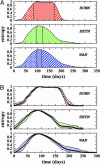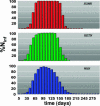The role of the airline transportation network in the prediction and predictability of global epidemics
- PMID: 16461461
- PMCID: PMC1413717
- DOI: 10.1073/pnas.0510525103
The role of the airline transportation network in the prediction and predictability of global epidemics
Abstract
The systematic study of large-scale networks has unveiled the ubiquitous presence of connectivity patterns characterized by large-scale heterogeneities and unbounded statistical fluctuations. These features affect dramatically the behavior of the diffusion processes occurring on networks, determining the ensuing statistical properties of their evolution pattern and dynamics. In this article, we present a stochastic computational framework for the forecast of global epidemics that considers the complete worldwide air travel infrastructure complemented with census population data. We address two basic issues in global epidemic modeling: (i) we study the role of the large scale properties of the airline transportation network in determining the global diffusion pattern of emerging diseases; and (ii) we evaluate the reliability of forecasts and outbreak scenarios with respect to the intrinsic stochasticity of disease transmission and traffic flows. To address these issues we define a set of quantitative measures able to characterize the level of heterogeneity and predictability of the epidemic pattern. These measures may be used for the analysis of containment policies and epidemic risk assessment.
Conflict of interest statement
Conflict of interest statement: No conflicts declared.
Figures





References
-
- Anderson R. M., May R. M. Infectious Diseases in Humans. Oxford: Oxford Univ. Press; 1992.
-
- Hethcote H. W., Yorke J. A. Lect. Notes Biomath. 1984;56:1–105.
-
- Kretzschmar M., Morris M. Math. Biosci. 1996;133:165–195. - PubMed
-
- Keeling M. Proc. R. Soc. London Ser. B; 1999. pp. 859–867. - PubMed
-
- Pastor-Satorras R., Vespignani A. Phys. Rev. Lett. 2001;86:3200–3203. - PubMed
MeSH terms
LinkOut - more resources
Full Text Sources
Other Literature Sources
Medical

